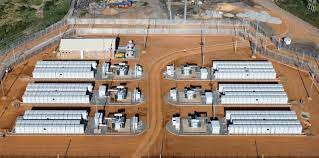Eskom, a company located in South Africa, launches Africa’s biggest battery energy storage facility to improve the storage of electricity in Africa.
The company has reported that the Hex Battery Energy Storage System project in Worcester, which is located in the Western Cape province, makes use of large-scale utility batteries that are meant to store sufficient energy to provide power to a South African town with roughly 100,000 inhabitants for almost five hours.
In an effort to put a stop to South Africa’s chronic electricity shortages, the state-owned power provider Eskom in South Africa has begun operating the most extensive battery energy storage plant on the African continent.
Read also: Eskom’s Kusile power station adds 800 megawatts to South Africa’s power grid
Why Hex battery facility is insufficient
According to a statement released by Eskom on Friday, the Hex Battery Energy Storage System project in Worcester, which is located in the Western Cape province, makes use of large-scale utility batteries designed to store sufficient energy to provide electricity to a South African town with roughly 100,000 inhabitants for almost five hours.
Because of a fleet of poorly maintained and unreliable coal-fired power plants, the utility has been unable to keep up with the demand for electricity, which has led to blackouts that have a negative impact on the economy.
The Hyosung Heavy Industries Corp. of South Korea and the Pinggao Group Co. of China were awarded the contract to construct such projects as part of a program supported by the World Bank last year.
Successful implementation will pave the way for broader adoption and possible export of the technology to other regions beyond the borders of South Africa,” Velaphi Ntuli, Eskom’s general manager for distribution and operations enablement, said in the statement.
About Eskom
Eskom is the primary provider of electrical power in South Africa and is a firm that is wholly controlled by the South African government. It is responsible for the generation and distribution of practically all of the nation’s electrical power. It is also the largest electrical provider in all of Africa, producing almost half of the total amount of electricity that is consumed across the continent. The Chief Executive Officer of Eskom is Calib Cassim.
The Government of the Republic of South Africa is the only shareholder of Eskom Holdings SOC Ltd, and the Minister of Public Enterprises acts as the shareholder representative for the company.
Eskom is responsible for the generation, transmission, and distribution of electricity to residential, commercial, industrial, agricultural, and mining clients, as well as to redistributors. To satisfy the ever-increasing demand for electricity in South Africa, numerous new power plants and significant new power lines are now under construction.
The majority of Eskom’s power comes from power plants that run on coal because it is their primary source of fuel. In addition to that, it manages nuclear, pumped-storage, gas-fired, and hydroelectric (water power) power facilities. There is a subcategory of hydroelectric plants known as pumped-storage plants that come online only during times of exceptionally high demand for electricity.
Due to its lack of productive and allocative efficiency, Eskom is regarded as a poor example of a monopolistic market structure. When the marginal cost of production is equal to the average cost of production, productive efficiency has been reached. On the other hand, allocative efficiency has been reached when the price is equal to the marginal cost of production.
About 95% of the electricity that is utilised in South Africa comes from Eskom, the vertically integrated power utility that is owned and operated by the South African government. Eskom is also responsible for producing a sizeable portion of the electricity produced on the African continent. Botswana, Lesotho, Mozambique, Namibia, Eswatini, and Zimbabwe are among the countries where it is sold.
